Organic Social Media Growth: Outgrowing Competitors Without Paid Ads
Achieve sustainable organic social media growth through comprehensive data and competitive analysis. Get proven strategies to outperform competitors without relying on paid advertising campaigns.


“Is organic growth dead?” The answer is no. However, it might seem like it because most brands are doing it wrong.
According to our data at Socialinsider, despite significant algorithm changes across all major platforms, accounts can still achieve remarkable organic growth in 2025—but only with a clear, strategic approach. While many marketers throw in the towel and pump their budgets into paid advertising, the smartest brands are doubling down on organic strategies that actually work.
The problem isn’t that organic growth is impossible. The problem is that everyone follows the same generic advice without understanding their competitive landscape.
The solution lies in strategic competitive analysis as your growth foundation. Instead of guessing what might work, you can reverse-engineer what’s already working for your competitors and industry leaders.
And here’s the kicker: you don’t have to choose between organic and paid strategies. The most successful brands combine both approaches—boosting their most successful organic posts to amplify reach, collaborating with other accounts to tap into different audiences, and using paid promotion to accelerate their organic wins.
In this article, I’ll show you a systematic approach to reverse-engineer your competitors’ success, identify the content gaps they’re missing, and build an organic growth strategy that’s based on real market data rather than generic best practices. By the end, you’ll have a clear roadmap to outgrow your rivals without relying on paid advertising.
Key takeaways
-
Organic growth isn't dead, but most brands fail because they follow generic advice instead of analyzing their specific competitive landscape
-
The solution is strategic competitive analysis - study your competitors' successful content, engagement tactics, posting patterns, and content pillars to understand what works with your shared audience
-
Focus on engagement rates over follower counts, and prioritize quality metrics like saves, shares, and conversion tracking rather than vanity metrics
-
Identify content gaps your competitors are missing - this becomes your opportunity to differentiate and stand out
-
Adapt successful competitor strategies rather than copying them directly, since context, brand voice, and audience relationships matter
-
Implement systematically: gather intelligence on 5-10 competitors, develop content pillars based on gap analysis, execute consistently while testing, and conduct monthly reviews to optimize
-
Algorithm changes and increased competition make generic strategies ineffective - you need data-driven insights specific to your market
-
Don't copy competitor content directly - extract the principles behind successful posts and adapt them authentically for your brand
-
The most successful brands combine organic content to build authentic relationships with paid promotion to amplify their best-performing posts
-
Monthly competitive reviews help you track market shifts, algorithm changes, and identify new opportunities before competitors do
-
Success comes from understanding why content works for competitors, then creating something even better based on real market data
What is organic social media growth?
When most marketers think of organic social media growth, they think of one simple definition: “growth without paid ads.” But that’s just scratching the surface. True organic social media growth is about building genuine connections, creating content that resonates so deeply with your audience that they can’t help but engage, share, and advocate for your brand.
Organic growth represents the compound effect of authentic engagement, and that’s exactly what makes it more valuable long-term than paid growth. Paid advertising can give you immediate results, but the moment you stop paying, the traffic stops flowing.
Organic growth, on the other hand, builds momentum over time. Each piece of valuable content you create becomes an asset that can continue attracting and engaging your audience months or even years later.
The current landscape challenge
However, let’s be honest about the challenges we’re facing in 2025. The organic social media landscape has become significantly more competitive and complex than it was just a few years ago.
1. Algorithm changes make organic reach harder
Social media platforms have continuously updated their algorithms, making organic reach increasingly challenging. Instagram’s algorithm now prioritizes content from close friends and family over brand content, unless that brand content generates exceptional engagement. LinkedIn’s algorithm has shifted toward favoring native video content and posts that spark meaningful professional conversations, making it harder for traditional promotional content to gain traction. And TikTok’s algorithm, while still offering the potential for viral organic reach, has become more sophisticated in detecting and limiting repetitive or low-quality content.
2. Increased competition for attention
The competition for audience attention has intensified dramatically. A paper from 2013 states that the average person is exposed to 3,000 to 5,000 brand messages per day across all channels (these numbers might be even higher today). On social media specifically, users are scrolling through hundreds of posts daily, spending mere seconds on each piece of content before moving on.
3. Cookie-cutter strategies don’t work anymore
The days of following generic “post at 2 PM on Tuesdays” advice are over—what works for one brand in one industry doesn’t translate for another, even within the same niche. That’s because these strategies don’t account for your specific audience’s preferences, your competitors’ activities, or the unique value proposition that sets your brand apart.
This is precisely why competitive analysis has become so crucial for organic growth. Instead of following one-size-fits-all advice, you need to understand what’s actually working in your specific market, for your specific audience, right now. Your competitors are your best source of market research because they’re testing content, timing, and strategies with the same audience you’re trying to reach.
Performing a competitive analysis to boost social growth
The best way to combat decreasing reach is to perform a competitive analysis. See who the people in your industry or niche are, what they like (best-performing posts for you and competitors, as well as industry benchmarks and most-engaged content pillars), then produce the exact content and formats your audience likes.
The beauty of this method is that your competitors have already done the hard work of testing different approaches with your shared audience. They've invested time and resources figuring out what resonates, and your job is to learn from their successes and failures, then create something even better.
How to perform a competitive analysis
When you start analyzing your competitors’ social media strategy, you need to focus on the metrics that actually matter for organic growth. Here’s what to analyze:
1. Measure engagement rates across different content types
Follower counts by themselves can be misleading. Instead, focus on engagement rates, which tell you how actively an audience interacts with content.
Engagement rates give you a clear picture of which competitors are truly connecting with their audience versus those who might have purchased followers or experienced engagement drops.
Because engagement is such a crucial metric, you’ll find it calculated in various ways in your Socialinsider dashboard, so you can choose the option that best fits your needs: by followers, by reach, by impressions, with or without clicks.
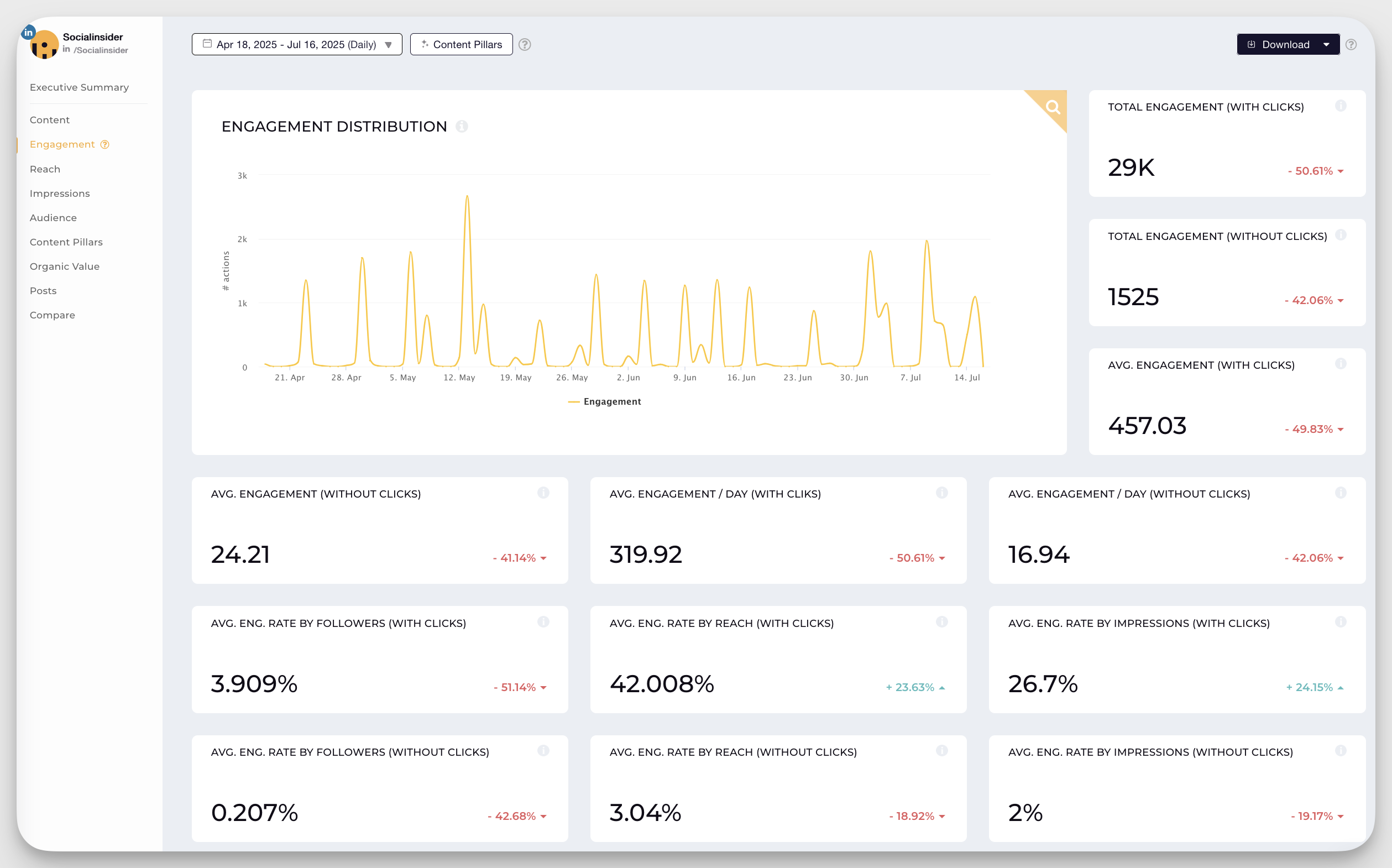
2. Identify content themes and formats that generate the most interaction
Pay attention to the types of content your competitors post most frequently.
Are they focusing on educational carousels, behind-the-scenes videos, user-generated content, or something else entirely? More importantly, which formats consistently receive the highest engagement?
This intelligence helps you understand what your shared audience actually wants to see.
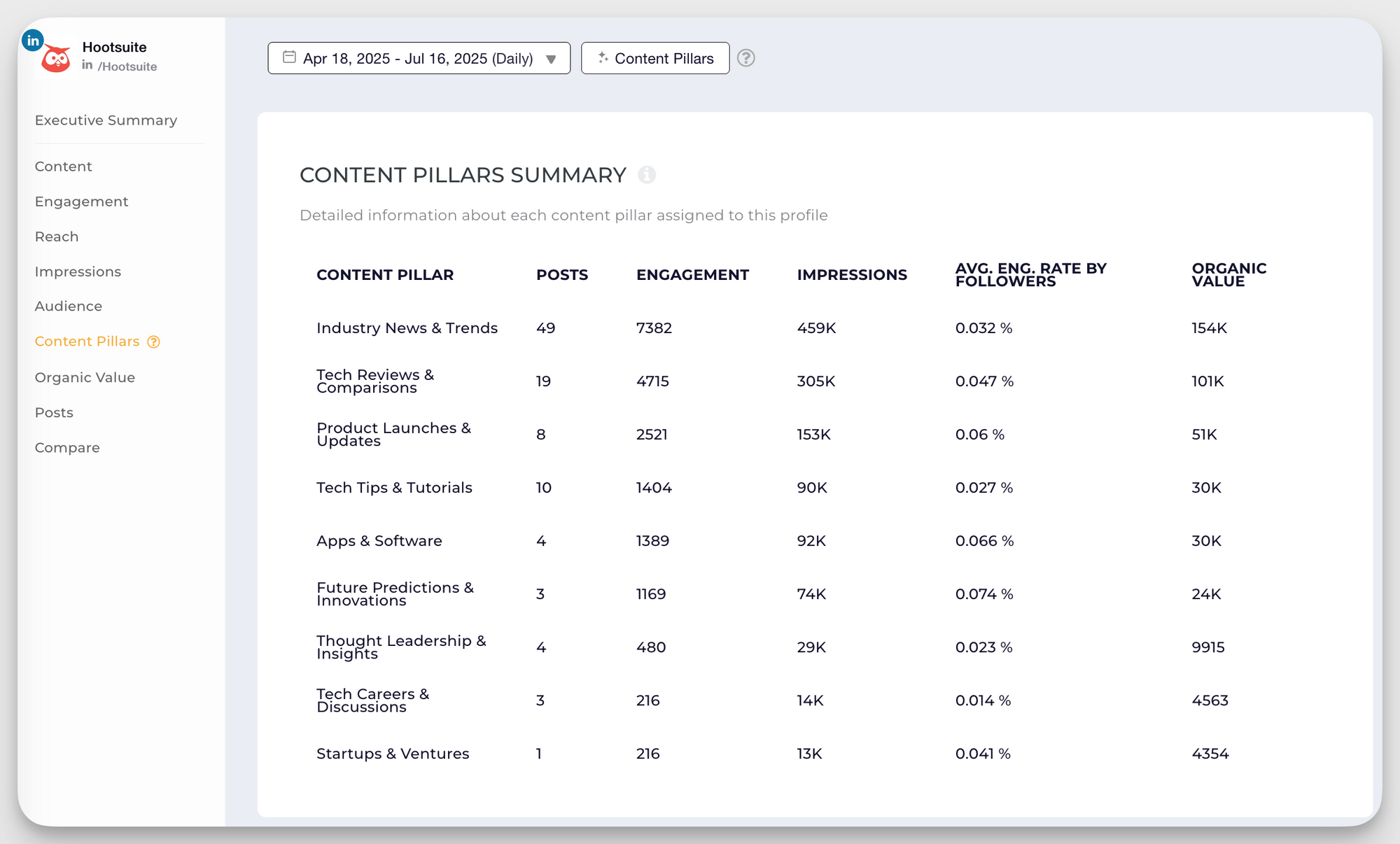
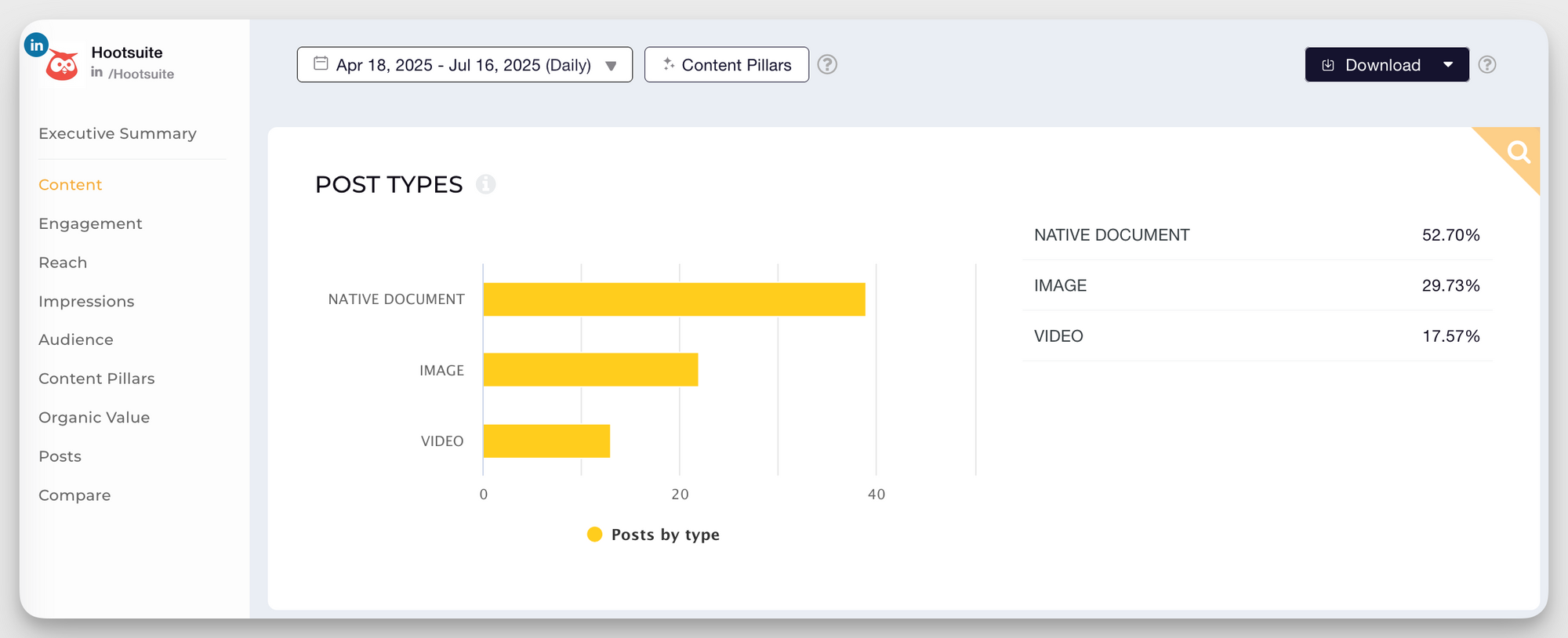
3. Notice posting frequency and optimal timing
Track not just how often your competitors post, but when they post. Are they maintaining a consistent schedule? Do they post more frequently on certain days?
Understanding their posting patterns can reveal insights about when your audience is most active and receptive to content.
4. Identify competitors’ content pillars
Content pillars are the core themes that make up a brand’s social media presence.
As you can see in the example below, this health and fitness brand focuses heavily on “Motivation & Inspiration” content, which makes up the majority of their posts. This tells us their audience responds well to motivational content, making it a proven pillar for this industry.
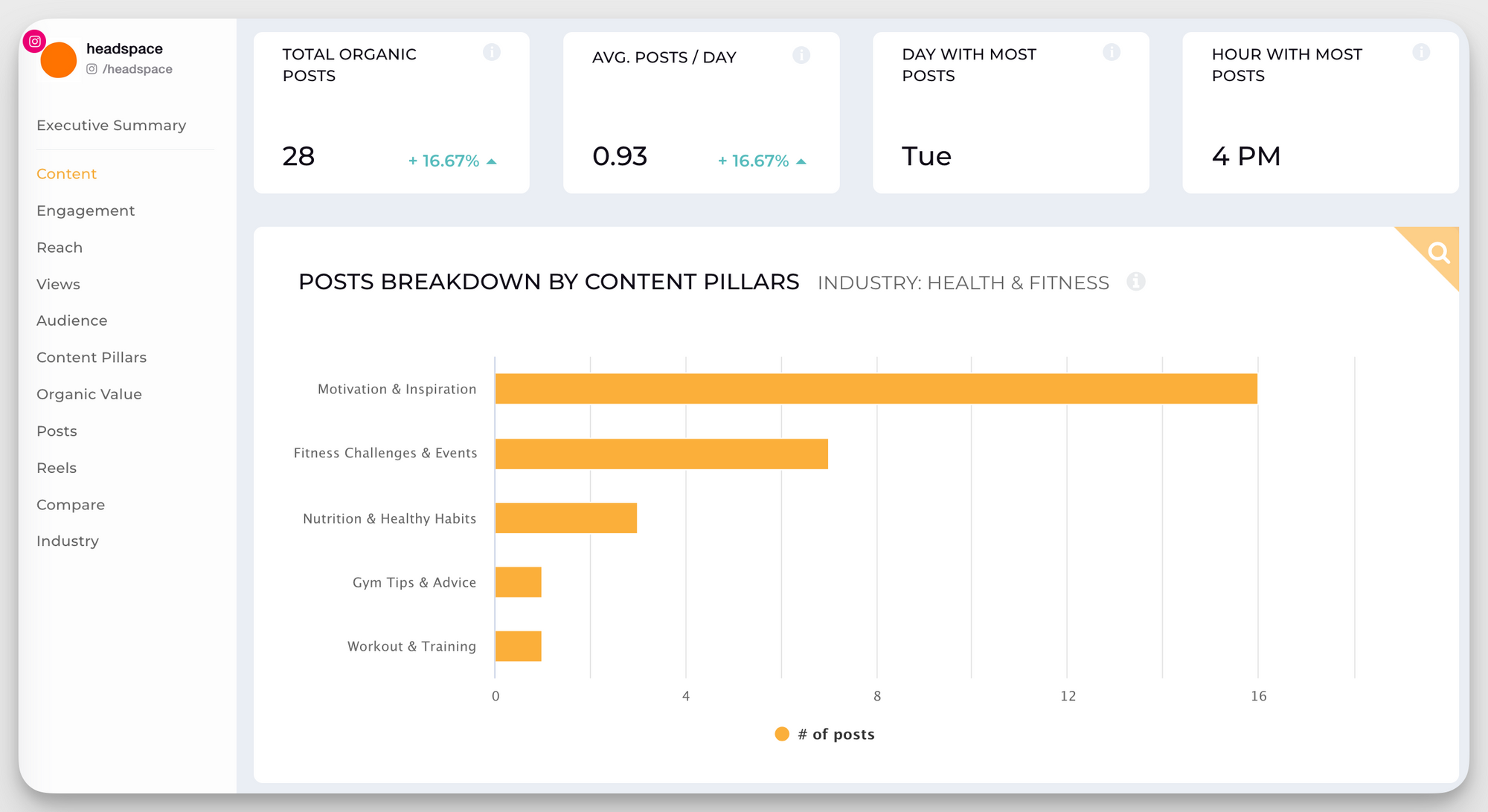
When you analyze content pillars with tools like Socialinsider, you’re getting a clear picture of what topics and themes resonate most with your shared audience. Notice how this brand is posting relatively little about workout and training specifics. This could represent a gap you could fill with your own content strategy, if operating in the same industry.
5. Understand competitors’ engagement tactics
Look at how competitors engage with their audience. Do they ask questions in their captions? Are they using interactive features like polls, quizzes, or question stickers?
These engagement tactics can significantly impact organic reach, as platforms reward content that generates meaningful interactions.
6. Map competitors’ growth patterns
Track your competitors’ follower growth over time using social media benchmarks to understand their growth trajectory. Are they experiencing steady, consistent growth, or do they have periods of rapid expansion followed by plateaus?
Understanding these patterns helps you set realistic expectations for your own organic growth and identify what might be driving their success during high-growth periods.
7. Use Socialinsider for competitive content analysis
Socialinsider’s analysis tools make competitive research straightforward and actionable. Instead of manually tracking competitors across multiple platforms, you can get comprehensive insights into their content performance, posting schedules, and engagement patterns in one place.
The platform allows you to compare multiple competitors simultaneously, giving you a broader view of what’s working across your industry. You can see which content pillars are driving the most engagement, identify gaps in your competitors’ strategies, and spot opportunities they’re missing.
Actionable implementation strategy
Now that you understand how to analyze your competitors, let’s see how to turn those insights into a systematic approach for organic social media growth.
Step 1: Intelligence gathering
- Complete competitive audit checklist — Start by conducting a thorough audit of your top 5-10 competitors (both direct and indirect). For each, document posting frequency, engagement rates, content themes, and optimal posting times. Create a spreadsheet tracking each competitor’s content pillars, average engagement per post type, and any patterns you notice in their posting schedule — or, better yet, use a social media analytics tool that has ready-made competitive intelligence dashboards.
- Identify top 10 insights from this analysis — After completing your audit, distill your findings into 10-15 actionable insights. These might include discoveries like “video content consistently outperforms static posts by 40%” or “educational carousel posts receive 3x more saves than promotional content.” Focus on clear opportunities for your brand. Maybe you notice that none of your competitors are posting about a specific topic your audience cares about, or perhaps they’re all posting at the same time, leaving certain hours completely free.
- Create your differentiation strategy — Use your competitive analysis to identify areas where your competitors are underperforming or absent. This becomes the foundation of your differentiation strategy. Instead of competing head-to-head in oversaturated content areas, you’ll focus on the gaps that give you the best chance of standing out.
Step 2: Content strategy development
- Develop content pillars based on gap analysis — Your content pillars should reflect both what’s working for competitors and what they’re missing. If your analysis shows that motivational content performs well but no one is addressing practical implementation, that’s your opportunity to create an “Actionable tips” pillar. Build 3-5 core content pillars that balance proven themes with your unique angle.
- Create a content calendar using competitive insights — Develop your content calendar based on the optimal posting times you discovered during your analysis. However, remember that each platform has its specificities, and what works on Instagram might not work on LinkedIn or TikTok. Stay flexible enough to jump on trends, but only if they make sense for your brand. The goal is to maintain consistency while remaining agile.
- Plan engagement and community-building tactics — Based on your competitors’ engagement strategies, develop your own approach to community building. If interactive content like polls and questions drives more meaningful conversations, incorporate those elements into your content planning. Create workflows for nurturing conversations and building relationships with your audience based on what you observed works best.
Step 3: Execution and testing
- Implement your new content strategy — Post consistently according to your planned schedule and pay attention to what’s working. Document which elements of your strategy immediately show promise and which need adjustment.
- Test engagement tactics — Experiment with different engagement approaches to see what resonates with your audience. Try varying your response times, question formats, and call-to-action styles. Test interactive features like polls, quizzes, and question stickers. Measure both the quantity and quality of responses to ensure you’re building meaningful connections.
- Monitor performance metrics — Socialinsider helps you pull all the key metrics in a single dashboard for easy analysis. The Executive Summary below simplifies the analysis by consolidating all the data in your dashboard and highlighting key points. The best part: you get recommendations or observations that you can use in your strategy immediately and include in social media reports.
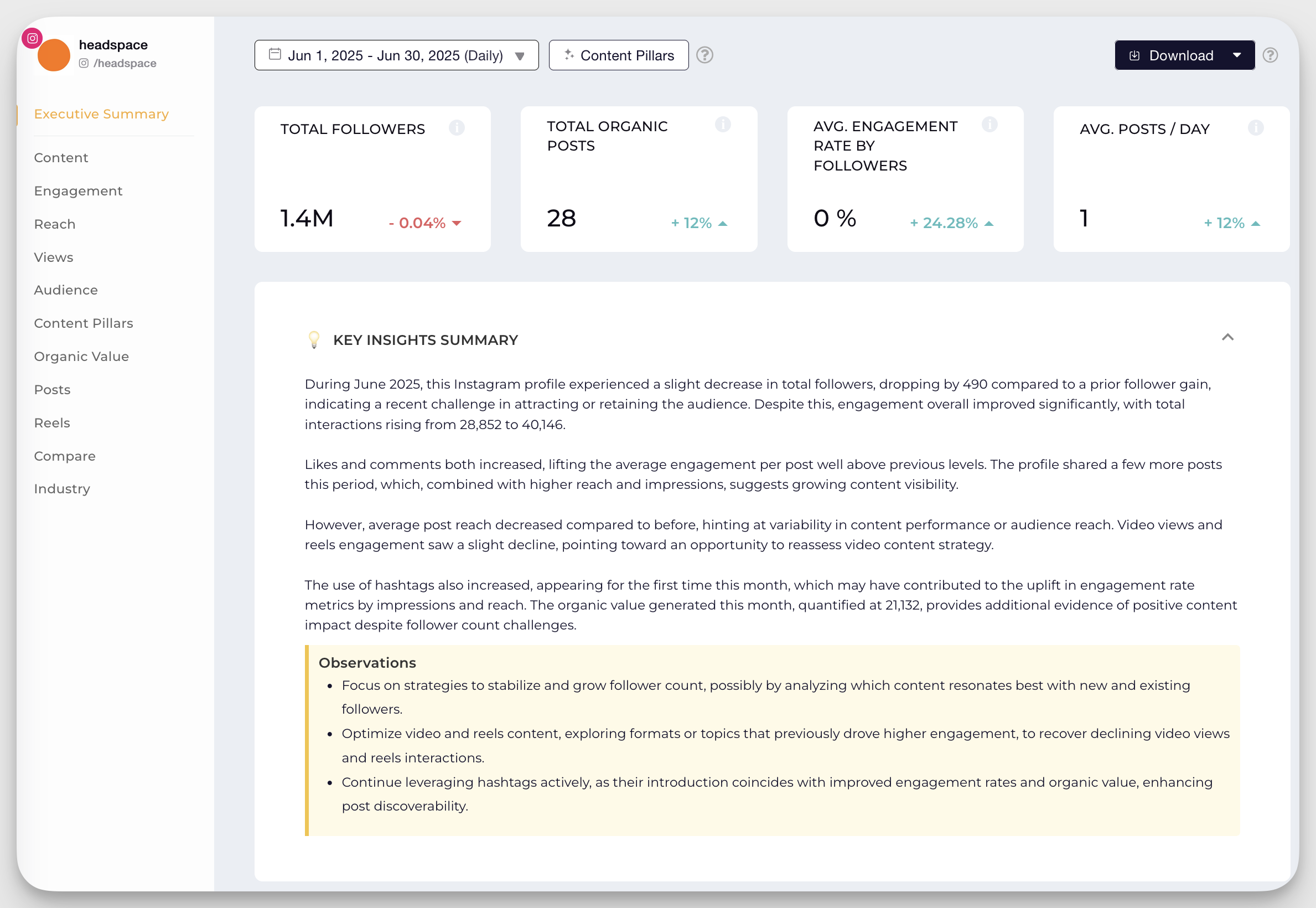
Step 4: Analysis and optimization
- Compare your performance to competitors and industry peers — The benchmark analysis below shows how one account compares to both a specific competitor and the industry average across multiple metrics. This type of analysis reveals critical insights about your competitive position. Use social media benchmarks to understand where you stand and set realistic but ambitious targets based on top performers’ achievements.
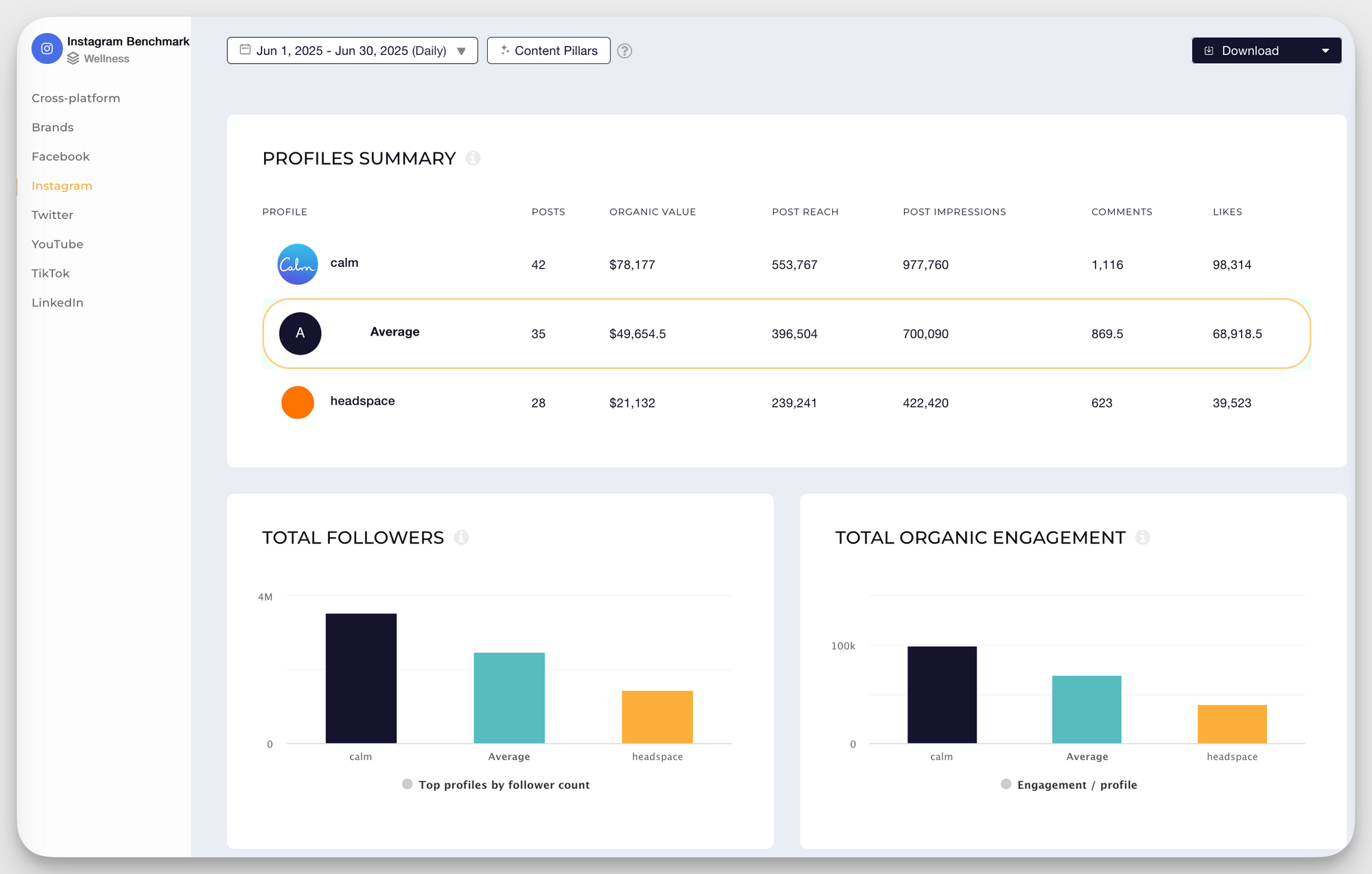
- Identify what’s working and what isn’t — Use both your own performance data and competitive benchmarks to identify patterns. Are certain content types consistently outperforming others? Are there specific days or times when your engagement drops? Are your competitors gaining ground in areas where you’re falling behind?
- Refine strategy for next month — Based on your analysis, adjust your strategy. Keep the content types, posting times, and engagement tactics that are working. Remove or modify approaches that aren’t performing well compared to competitor standards. Most importantly, develop new strategies to test based on gaps you’ve identified or successful tactics you’ve observed.
Measuring and optimizing your organic growth
The difference between brands that achieve sustainable organic social media growth and those that get stuck lies in measurement and optimization.
While many brands get caught up in vanity metrics, successful social media marketers focus on indicators that actually predict long-term business growth and competitive advantage.
The key is to understand not only how you’re progressing but how you’re doing relative to your competitors and the broader market.
Let’s break down the process into metrics, review frequency, and scaling opportunities.
Measure social media metrics that matter
Knowing what to measure is essential to avoid data overload and useless analysis.
Beyond vanity metrics: engagement quality
Follower count and total likes might look impressive in reports, but they don’t tell you much about your organic growth strategy’s effectiveness. Smart social media strategists focus on engagement quality metrics that indicate genuine audience connection and business impact.
Look at your engagement rate per post, but go deeper. Analyze comment sentiment and the types of conversations your content sparks. Are people tagging friends? Are they sharing your posts to their Instagram stories? These behaviors show that your organic content is creating real value. Save rates and shares are particularly valuable metrics because they represent genuine interest.
Track these metrics over time and compare them to your social media reach patterns to understand which content creates the most meaningful connections.
Use Socialinsider’s Organic Value feature to measure the value of your organic efforts
Recently, we’ve launched a new feature that enables you to calculate the value of your organic posts so you can finally show your manager cold, hard numbers. Basically, what this feature shows you is how much you should have invested in paid ads to get the same results you are seeing from your organic posts.
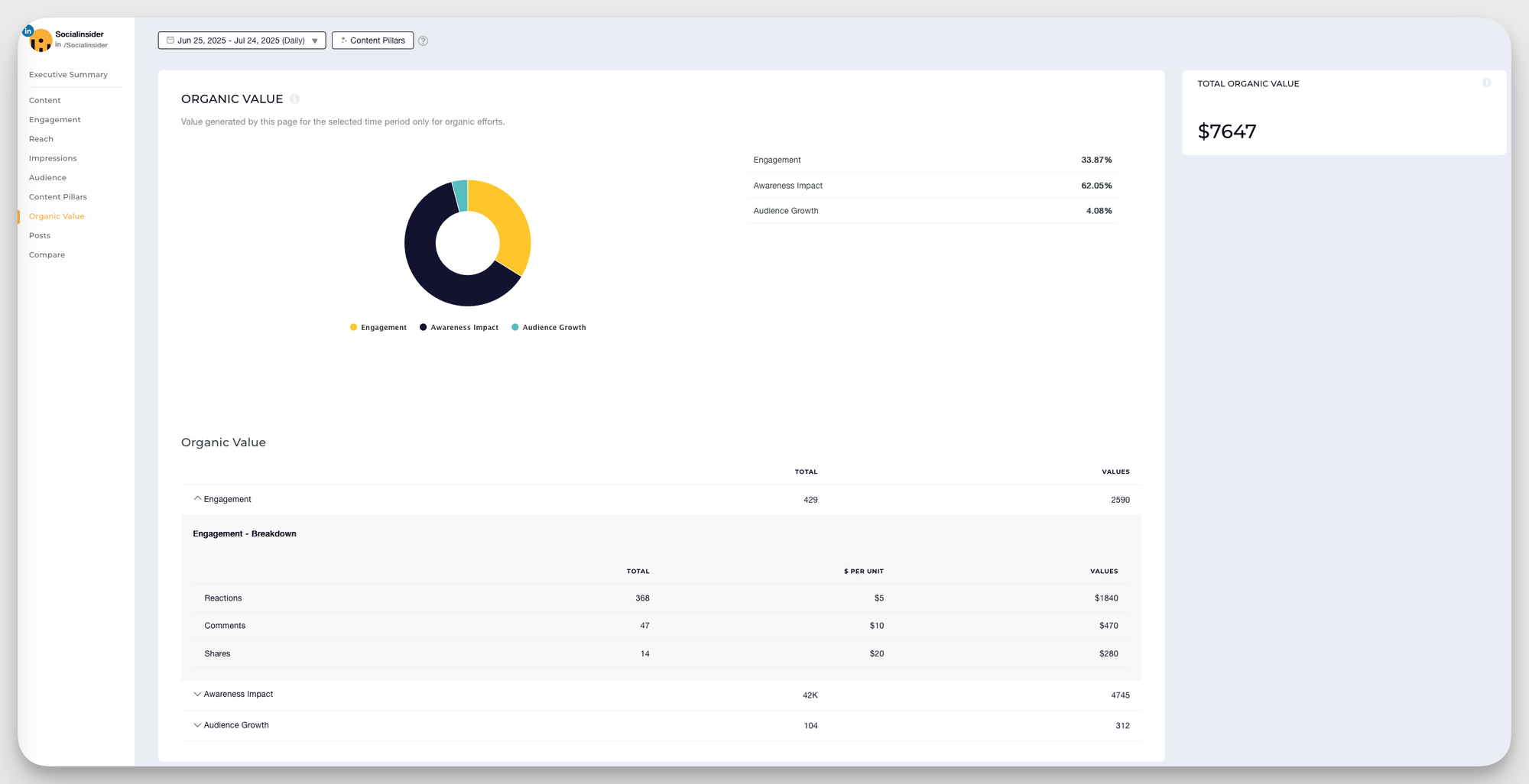
The default numbers are pre-filled based on platform benchmarks, but you can also enter your own numbers for a more accurate estimate.
Growth rate benchmarking against competitors
Raw follower numbers can be misleading, but growth rates tell a more accurate story about your organic social media marketing performance.
Calculate your monthly growth rate and compare it to your top competitors using social media benchmarks to understand whether you’re gaining or losing ground.
Sudden spikes or drops in growth rate often correlate with specific content choices or external factors that you can learn from and replicate or avoid.
Long-term value indicators
Pay attention to the quality of your growth as well as the quantity. Rapid follower increases that aren’t accompanied by proportional engagement increases often indicate low-quality growth that won’t translate to business results.
The best organic growth happens when your engagement rate either maintains or improves as your follower count increases.
Monitor your audience quality by tracking metrics like profile clicks, website visits, and conversion rates from social media traffic. Use social media conversion tracking to connect your organic efforts to actual business outcomes.
Also, track your content’s lifespan, meaning how long posts continue generating engagement after the initial hype. High-quality organic content often has extended engagement periods, continuing to attract comments, saves, and shares weeks or months after posting. This contributes to better algorithmic performance and produces compounded results. Here are some interesting insights from Measure.studio.
Perform monthly competitive reviews
Competitive analysis is best done monthly, allowing enough time for new data to gather, but not letting trends and opportunities pass you by.
Track competitor changes and adaptations
Your competitors’ strategies aren’t static, and neither should your analysis be. Set up monthly reviews to track how competitor content strategies, posting frequencies, and engagement tactics evolve.
Use social media analysis tools to identify when competitors make significant changes to their approach and monitor the results.
Pay particular attention to competitors who experience sudden growth spurts or engagement increases. Analyze what changed in their strategy during those periods. These insights can help you stay competitive.
When a competitor tries a new content format or posting strategy, track its performance and learn from it. This intelligence helps you make informed decisions about which trends to adopt and which to avoid — and saves you resources.
Adjust your strategy based on market shifts
Use competitive intelligence to identify market trends that affect organic growth.
Are engagement rates declining industry-wide, or are they dropping only for certain types of content? Are competitors successfully using new content formats or platform features that you haven’t tried yet?
Adapt your strategy proactively rather than reactively. If you see competitors successfully increasing their video content engagement, don’t wait until your static post performance declines to shift. Early adoption of successful trends can give you a competitive advantage in organic growth.
Monitor seasonal patterns and industry-specific events that impact organic performance. Understanding when your audience is most engaged throughout the year helps you plan content calendars that maximize organic reach during peak periods and adjust expectations during slower times.
Stay up to date with algorithm changes
Platform algorithms change frequently, and these updates can significantly impact your organic social media performance.
While platforms don’t always announce algorithm changes, you can detect them by monitoring sudden shifts in your content performance. When you notice unusual patterns, check if competitors are experiencing similar changes. If the shifts are industry-wide, it likely indicates an algorithm update that requires strategy adjustments.
Stay informed about announced platform updates and test their impact on your content performance. When platforms introduce new features or change their content prioritization, experiment with adjusting your strategy to align with these changes. Early adaptation to algorithm updates often provides temporary advantages in organic reach and engagement.
Scale your organic growth
Knowing when and how to expand to new platforms is a social media art in itself. Scale too quickly, and your resources get spread too thin. Lag behind, and you can become outdated and miss opportunities.
Identifying expansion opportunities
Before expanding to new platforms, ensure you’ve maximized your potential on your current platforms. Sustainable organic growth strategy involves mastering one or two platforms before spreading your efforts across multiple channels.
Use competitive analysis to determine if competitors are active on platforms where you’re not present. Evaluate new platforms based on where your target audience spends time and whether your content format translates well to different platform specifications.
A brand that succeeds with long-form educational content on LinkedIn might struggle on TikTok without significant format adaptation. Consider whether you have the resources to create platform-specific content rather than simply repurposing existing material.
Resource allocation for platform expansion
Expanding to new platforms requires dedicated resources for content creation, community management, and performance tracking. Calculate the time and budget needed to maintain consistent, high-quality posting on additional platforms before making expansion decisions.
Take it easy. Choose one new platform and commit to understanding its unique audience and algorithm before adding more channels.
Why you should not copy others directly
One of the biggest mistakes brands make when implementing competitive analysis for organic growth is thinking they should directly copy successful content from others. While it’s tempting to see a competitor’s viral post and recreate it, this approach can backfire.
Competitive analysis is about understanding why a post worked for others and then deciding whether you can adapt the concept authentically for your brand.
Why direct copying backfires
Direct copying fails because it ignores the crucial context that made the original content successful. What works for one brand reflects their unique voice, audience relationship, timing, and market position. When you copy without understanding these underlying factors, you end up with content that feels inauthentic and often confuses your audience about what your brand actually stands for.
Take, for example, Ryanair’s social media presence, which is wildly popular, thanks to its self-deprecating humour and sharp wit that matches its low-cost, no-frills brand. They know their flights are cheap and they own all the “flaws” that come with maintaining their prices low. There’s no point trying to pretend they’re something else.
However, when other airlines (or unrelated brands) try to adopt a similarly sarcastic tone, the results often fall flat because their context is different. Without Ryanair’s specific positioning and audience expectation, the sarcasm can come across as rude or unprofessional.
Copying tone without strategic alignment can confuse or alienate your audience.
How to adapt rather than imitate
Smart competitive analysis involves extracting the principles behind successful content rather than copying the execution. It’s about understanding the “why”, not just the “how”.
Start by identifying the core strategy behind successful content and focus on adapting successful content frameworks rather than specific content ideas. If educational carousel posts work well for competitors, create your own educational carousels using your unique expertise and perspective.
Pay attention to timing and context when adapting successful content ideas. What worked for a competitor during a specific event, season, or market moment might not work for you at a different time or in different circumstances. Adapt the underlying strategy while ensuring the timing and context align with your brand's situation and audience needs.
Final thoughts
The most successful brands integrate both organic and paid social media. Use organic content to build authentic relationships and showcase value. Then, amplify your top-performing organic posts with paid promotion to extend their reach. This hybrid approach combines the authenticity of organic growth with the expansive reach of paid advertising.
Comprehensive social media insights and competitor analysis are essential for both organic and paid strategies. You can’t stand out through all the social media noise without data to back up your strategy and decisions. Give Socialinsider a free try today and get the insights to develop a high-performing organic growth strategy.
FAQs about organic social media growth
1. What does organic social media growth mean?
Organic social media growth refers to the process of expanding your audience and influence on social media without using paid advertising. It involves building authentic connections, sharing valuable content, and actively engaging with your community to foster trust and loyalty over time. The focus is on genuine interactions rather than quick, paid boosts.
2. What is the 5 5 5 rule on social media?
The 5 5 5 rule is a simple strategy for boosting your social media presence efficiently. While there are a few interpretations, the most common is to comment on 5 posts and like 5 posts within 5 minutes (or, in some versions, to do five meaningful actions each day across platforms, or to spend five minutes each on engagement, content creation, and analysis).
3. How to organically grow social media followers?
To grow social media followers organically, the most effective strategy is to perform a competitive analysis using a social media analytics platform like Socialinsider. This helps you identify what’s working for competitors and industry leaders—such as top-performing content types, posting times, and engagement tactics—so you can apply these insights to your own strategy. Make sure to also focus on consistency, authentic engagement, and high-quality content, and interact regularly with your audience, respond to comments, and foster a sense of community.
4. What is the best social media platform for organic growth?
TikTok is currently the best platform for organic growth. Its engagement rates are significantly higher than those of other major platforms—often by a wide margin—and the algorithm is designed to give content from smaller accounts a real chance to go viral. This means even new or less-followed creators can achieve substantial reach and engagement, especially compared to platforms like Instagram or Facebook, where algorithms tend to favor established, large accounts.
Analyze your competitors in seconds
Track & analyze your competitors and get top social media metrics and more!
You might also like
Improve your social media strategy with Socialinsider!
Use in-depth data to measure your social accounts’ performance, analyze competitors, and gain insights to improve your strategy.




